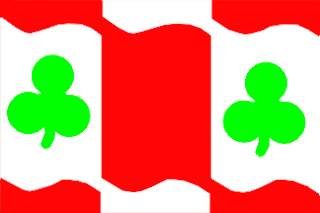When Marja and I went walking in Leons it was a terribly cold, greyday.
This is me (Grace Lee) dressed up for the cold and rain and mud.
At first when entering Leons, you came across their famous boards with the villages name and coat of arms on (which I just love).
The white house behind the board.
There was a house bordering the side of the road and when we walked past there were two ladies from the village sitting at a table with their sewing machines placed on top and a cup of coffee next to them and sewing away and chatting.
How lovely and homely it looked, and as we passed by they waved to us, how friendly.
As you continue down the road (which is the main one in and out), we came across the church in Leons, and right outside the church was a bus stop.
The church Saint Catherine as it was once known.
The churches bell tower was renewed in recent years and originally had a sadle roof (Zadeldak). The church centuries ago was known as 'Saint Catherine' (I do not know which one)? as there are many.
The church is rather a large church for such a small village with very few inhabitants.
Next to the church was the priory (pastorij), where the priest resides.
Priory (Pastorij).
Scenic pictures around Leons.
We found once again the emblem on a street sign for the Saint Jacob (jabikpaad) route for instance, where people like Saint James, (which the dutch name is Jabik for James) walked , which is known as 'Santiago de campostilla'. Which thousands of Pilgrams walk each year.
Here in The Netherlands you can walk (begining) from St Jacob parochie to (ending back) Saint Jacobparochie, as a pilgrams route if you wanted, also right up to Zwarte Haan (which I mentioned in one of my earlier chapters).
You can get get a brochure from the Municipality St Anna parochie,(Gemeente Annaparochie), post box (postbus) 94, 9076 ZN, St.Annaparochie, called,'t Bildt for (euro's) 3.50.
Farmers dairy farm.
This little village attracted me very much, it is a very agricultural land and had big Friesian cows. we passed this farmers dairy farm, and all these cows were in a barn and munching there hay and I just had to take a photograph, one cow in particular just stared at us while munching away.
Friesian dairy cows and Black Sheep.
Leons (Dutch: lions), village falls under the municipalityLittenseradiel, it used to fall under the former municipality of Baarderadeel as the village Hxfans (Dutch: Huins).
These are two separate twin-villages, which share one flag, but each own a Coat of Arms (CoA).
In the 19th century a brick-factory was founded (c. 1829-1893)
Leons (Dutch name: Lions),is the smallest village in Baarderadeel.
Nickname: Leonzer wynhxfbnen (greyhouds: boasters).
Leons CoA: in red a golden cornsheaf; a silver shieldborder, charged with six green clovers, placed 3:2:1.
image by Jarig Bakker, 7 Sep 2003
adopted 1999; Design: J.C. Terluin and R.J. Broersma.
Húns/Leons villages (Huins/Lions)
Three vertical stripes, red, white,red, each charged with a tile countercharged, placed between 1/10 and9/10 of glagheight, and the left and right ends coninciding with hoistand fly; the white tiles charged with a green clover of 1/2 flagheight.
The corn sheaf from the Leonder arms is from the CoA of the Siccama family, which owned a "state"in the village. The shield border refers to the meadows and cattle-breeding.
For both villages one flag was designed. The tiles not only represent the brickfactory, but also the fact that people need to have a roof over their heads, otherwise they would be roofless.
The white tiles are charged with clovers to designate the agriculturalcharacter of the villages.(According to Jarrig Bakker : F.O.T.W. (Flags of the world).












No comments:
Post a Comment